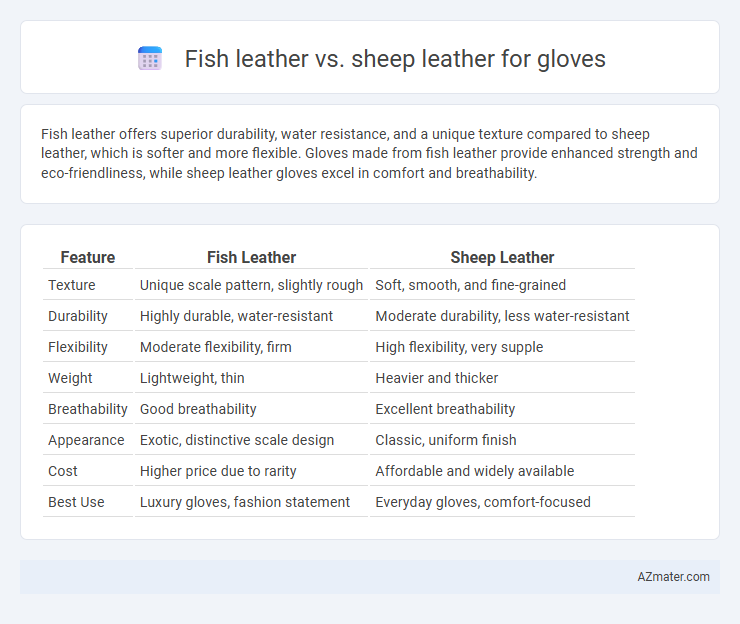Fish leather offers superior durability, water resistance, and a unique texture compared to sheep leather, which is softer and more flexible. Gloves made from fish leather provide enhanced strength and eco-friendliness, while sheep leather gloves excel in comfort and breathability.
Table of Comparison
| Feature | Fish Leather | Sheep Leather |
|---|---|---|
| Texture | Unique scale pattern, slightly rough | Soft, smooth, and fine-grained |
| Durability | Highly durable, water-resistant | Moderate durability, less water-resistant |
| Flexibility | Moderate flexibility, firm | High flexibility, very supple |
| Weight | Lightweight, thin | Heavier and thicker |
| Breathability | Good breathability | Excellent breathability |
| Appearance | Exotic, distinctive scale design | Classic, uniform finish |
| Cost | Higher price due to rarity | Affordable and widely available |
| Best Use | Luxury gloves, fashion statement | Everyday gloves, comfort-focused |
Introduction to Fish Leather and Sheep Leather
Fish leather, derived from species such as salmon, perch, and cod, offers a durable and sustainable alternative to traditional sheep leather, characterized by its unique scale patterns and high tensile strength. Sheep leather is known for its softness, flexibility, and natural breathability, making it a popular choice for comfortable and lightweight gloves. The distinct textures and environmental impacts of fish leather versus sheep leather influence their selection for glove manufacturing, with fish leather being favored for eco-conscious consumers seeking innovative materials.
Origin and Sourcing of Fish and Sheep Leather
Fish leather, primarily sourced from species like salmon, perch, and cod, is often a byproduct of the fishing industry in regions such as Scandinavia and Japan, emphasizing sustainable use of fish skins that would otherwise be discarded. Sheep leather, typically derived from breeds raised in countries with established sheep farming like Australia, New Zealand, and parts of Europe, involves sourcing from tanneries specializing in high-quality sheepskins known for their soft texture and durability. The origin and sourcing of fish leather highlight eco-friendly practices and traceability linked to aquatic ecosystems, while sheep leather relies on agricultural livestock management and established farming traditions.
Physical Properties: Strength and Durability Comparison
Fish leather exhibits exceptional tensile strength and flexibility due to its dense collagen fiber structure, often surpassing sheep leather in durability. The natural grain pattern in fish leather provides enhanced abrasion resistance, making it highly suitable for gloves requiring long-lasting wear and tear performance. Sheep leather, while softer and more pliable, generally offers less resistance to stretching and abrasion, leading to reduced durability under heavy use conditions.
Breathability and Comfort for Glove Use
Fish leather offers superior breathability compared to sheep leather due to its unique fiber structure, allowing better moisture evaporation and enhanced comfort for prolonged glove use. Sheep leather, while softer and more pliable, tends to retain more heat and moisture, potentially reducing overall comfort during extended wear. For gloves requiring high breathability and moisture management, fish leather provides a more breathable and comfortable option, especially in active or warm conditions.
Flexibility and Dexterity: Performance in Gloves
Fish leather demonstrates superior flexibility and dexterity compared to sheep leather in glove performance, due to its fine grain and thinner structure which allows for better movement and comfort. The natural fibers in fish leather enable gloves to conform more closely to hand movements, enhancing precision and tactile sensitivity in tasks requiring fine motor skills. Sheep leather, while durable, tends to be thicker and less pliable, resulting in gloves that can restrict flexibility and reduce overall dexterity during use.
Environmental and Sustainability Considerations
Fish leather offers a more sustainable alternative to sheep leather for gloves due to its utilization of by-products from the fishing industry, reducing waste and environmental impact. It requires less land, water, and greenhouse gas emissions compared to sheep leather, where traditional livestock farming contributes significantly to deforestation and methane production. The natural durability and biodegradability of fish leather further enhance its eco-friendly profile, making it an appealing choice for environmentally conscious consumers.
Aesthetic Appeal: Texture and Appearance
Fish leather offers a unique aesthetic appeal with its distinct scale patterns and natural iridescence, creating a textured surface that stands out in glove design. Sheep leather features a smooth, consistent grain that provides a classic and elegant look, prized for its softness and subtle shine. The choice between fish and sheep leather for gloves depends on the desired visual impact, with fish leather delivering a bold, exotic appearance and sheep leather offering timeless sophistication.
Water Resistance and Maintenance Requirements
Fish leather offers superior water resistance compared to sheep leather due to its dense scale structure and natural oils, making it ideal for gloves exposed to moisture. Sheep leather, while softer and more breathable, tends to absorb water more readily, requiring frequent conditioning and waterproofing treatments to maintain durability. Maintenance of fish leather gloves is minimal, typically involving gentle wiping and occasional oiling, whereas sheep leather gloves need regular cleaning and moisturizing to prevent cracking and water damage.
Price and Market Availability
Fish leather gloves typically cost 20-30% more than sheep leather gloves due to limited supply and specialized processing methods. Sheep leather remains widely available and more affordable, benefiting from established tanning industries and economies of scale. The niche market for fish leather gloves is growing but still small, making sheep leather the dominant choice for price-sensitive consumers.
Conclusion: Choosing the Best Leather for Gloves
Fish leather offers superior durability, water resistance, and unique texture, making it an excellent choice for high-performance gloves requiring enhanced grip and flexibility. Sheep leather provides exceptional softness, breathability, and comfort, ideal for gloves used in everyday wear or delicate tasks. Selecting between fish and sheep leather depends on balancing durability and tactile sensitivity to meet specific glove performance needs.

Infographic: Fish leather vs Sheep leather for Glove
 azmater.com
azmater.com